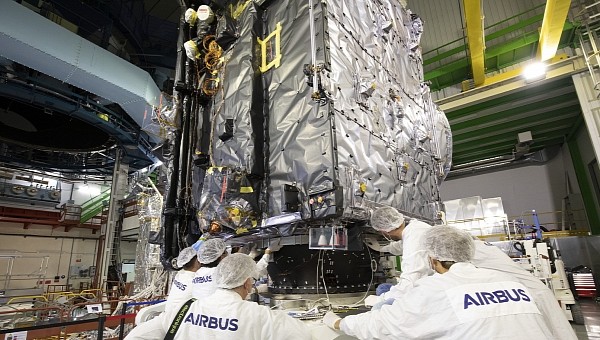Jupiter and its largest moons first revealed themselves to Galileo Galilei in 1610. Today, a spacecraft bearing a commemorative plaque in honor of the Italian astronomer is getting ready to travel through space and reach this giant planet, giving the world a more in-depth view.
Before it sets off on this historic space flight, JUICE (Jupiter Icy Moons Explorer) needs to embark on a different kind of journey. Since the summer of 2021, it’s been sitting at the Airbus center in Toulouse, France, for its final assembly and tests.
After its official unveiling (where everyone could admire the commemorative plaque) the spacecraft was loaded onto a massive Antonov cargo aircraft that will carry it across the Atlantic, all the way to South America. The final destination, to be reached by February, is Europe’s Kourou spaceport in the French Guiana. This is where an Ariane 5 launch vehicle will lift off a few months later, in April.
That will be the beginning of JUICE’s real journey, the one that will go down in history. This is the largest planetary mission to this day for ESA (European Space Agency) and the spacecraft itself is the first L-class (L stands for Large) mission in the Cosmic Vision program, dedicated to the planets in the Solar System.
Jupiter and the largest of its 79 moons (Ganymede, Callisto, Io and Europa) are the target for this particular mission. With no fuel, Juice weighs around 2,400 kg (2.4 tons). When fueled, its weight will increase to more than six tons. Onboard, it will carry ten scientific instruments, including sensors, cameras, an altimeter, and an ice-penetrating radar.
Two of these instruments were developed with help from the Institute of Planetary Research at the DLR (the German Aerospace Center). Plus, the German Space Agency contributed to the funding of seven of them.
After being flown from one continent to another, JUICE will be ready to set off on its epic journey to Jupiter, which it will reach by the summer of 2031. Once there, it will use its state-of-the-art instruments to map out Jupiter’s icy moons in much more detail than ever before (compared to NASA’s Voyager and Galileo missions). At best, it will shed more light on the elusive oceans of these moons.
Europa, for example, could be hiding more water than all of the oceans on Earth, under a thick layer of ice. Thanks to these ultra-capable instruments, scientists could at least get a confirmation for the presence of water on these four moons, and more information about it.
In the Fall of 2035, when its mission is supposed to end, JUICE will “die” like a hero, through a carefully-controlled crash into the icy surface of Ganymede. By then, it will have already written one of the most important pages in space exploration history.
After its official unveiling (where everyone could admire the commemorative plaque) the spacecraft was loaded onto a massive Antonov cargo aircraft that will carry it across the Atlantic, all the way to South America. The final destination, to be reached by February, is Europe’s Kourou spaceport in the French Guiana. This is where an Ariane 5 launch vehicle will lift off a few months later, in April.
That will be the beginning of JUICE’s real journey, the one that will go down in history. This is the largest planetary mission to this day for ESA (European Space Agency) and the spacecraft itself is the first L-class (L stands for Large) mission in the Cosmic Vision program, dedicated to the planets in the Solar System.
Jupiter and the largest of its 79 moons (Ganymede, Callisto, Io and Europa) are the target for this particular mission. With no fuel, Juice weighs around 2,400 kg (2.4 tons). When fueled, its weight will increase to more than six tons. Onboard, it will carry ten scientific instruments, including sensors, cameras, an altimeter, and an ice-penetrating radar.
Two of these instruments were developed with help from the Institute of Planetary Research at the DLR (the German Aerospace Center). Plus, the German Space Agency contributed to the funding of seven of them.
After being flown from one continent to another, JUICE will be ready to set off on its epic journey to Jupiter, which it will reach by the summer of 2031. Once there, it will use its state-of-the-art instruments to map out Jupiter’s icy moons in much more detail than ever before (compared to NASA’s Voyager and Galileo missions). At best, it will shed more light on the elusive oceans of these moons.
Europa, for example, could be hiding more water than all of the oceans on Earth, under a thick layer of ice. Thanks to these ultra-capable instruments, scientists could at least get a confirmation for the presence of water on these four moons, and more information about it.
In the Fall of 2035, when its mission is supposed to end, JUICE will “die” like a hero, through a carefully-controlled crash into the icy surface of Ganymede. By then, it will have already written one of the most important pages in space exploration history.






